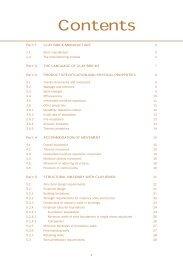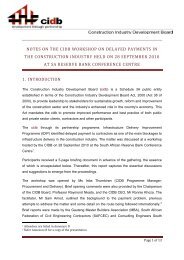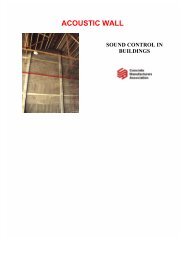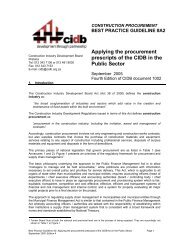MANUAL 4 - Construction Industry Development Board
MANUAL 4 - Construction Industry Development Board
MANUAL 4 - Construction Industry Development Board
Create successful ePaper yourself
Turn your PDF publications into a flip-book with our unique Google optimized e-Paper software.
<strong>MANUAL</strong> 4 – BITUMINOUS PAVEMENT SEALS<br />
4.4 Application of sand cover or second Otta seal<br />
4.4.1 Preparation of surface<br />
The first seal must be allowed to cure for a period of eight to twelve weeks, as directed by<br />
the engineer, depending on the curing conditions and the binder type before applying the<br />
following sand or Otta seal.<br />
4.4.2 Application of binder<br />
As for Section 4.2<br />
4.4.3 Application of aggregate<br />
As for Section 4.3<br />
4.4.4 Brooming of surface<br />
As for Section 4.3.2<br />
4.4.5 Rolling of the surface<br />
As for Section 4.3.2<br />
4.4.6 Control of traffic<br />
As for Section 4.3.2<br />
4.4.7 Immediate post construction care<br />
As for Section 4.3.2<br />
5. Notes to designer/consultant<br />
5.1 General<br />
Description<br />
The Otta seal originated in Norway and was developed by the Norwegian Public Roads<br />
Administration.<br />
Basically it consists of the application of a relatively thick film of comparatively soft bituminous<br />
binder, sprayed on a prepared/constructed base. This is covered with a graded aggregate<br />
which is well rolled with a pneumatic roller to provide a 16 – 32 mm thick bituminous<br />
surfacing. The excess aggregate has to be broomed off.<br />
The binder, under rolling and trafficking, can work its way through<br />
the aggregate – giving a premix-like appearance. During the first<br />
four to six months of service, the surface may appear to be rich<br />
in bitumen or may even bleed. This necessitates the spreading of<br />
sand or crusher dust over the affected areas to absorb the excess<br />
bitumen.<br />
The treated road is allowed to cure for eight to twelve weeks before<br />
a sand cover seal or second Otta seal is applied.<br />
This type of surfacing contrasts with the conventional seal<br />
surfacing, where a single sized crushed aggregate is placed and<br />
compacted on a film of binder, with the objective of the aggregate<br />
adhering to the binder.<br />
Note<br />
IMPLEMENTING EMPLOYMENT INTENSIVE ROAD WORKS 81<br />
The Otta seal requires the use of a hot penetration<br />
bitumen (generally 150/200) binder which has to be<br />
applied by tanker.<br />
A pneumatic roller is required to effectively roll the<br />
aggregate (28/30 ton loaded).<br />
Before the use of the Otta seal is considered an analysis<br />
of comparative costs or cost effectiveness must be<br />
made.<br />
The skid resistance of the Otta seal must be carefully<br />
monitored where excessive bleeding occurs.<br />
MODULE<br />
1<br />
2<br />
3<br />
4<br />
5<br />
6<br />
7












